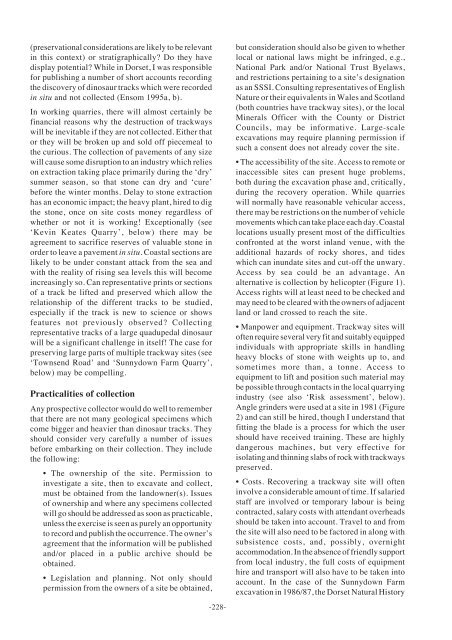Continental trace fossils and museum exhibits - Geological Curators ...
Continental trace fossils and museum exhibits - Geological Curators ...
Continental trace fossils and museum exhibits - Geological Curators ...
Create successful ePaper yourself
Turn your PDF publications into a flip-book with our unique Google optimized e-Paper software.
(preservational considerations are likely to be relevantin this context) or stratigraphically? Do they havedisplay potential? While in Dorset, I was responsiblefor publishing a number of short accounts recordingthe discovery of dinosaur tracks which were recordedin situ <strong>and</strong> not collected (Ensom 1995a, b).In working quarries, there will almost certainly befinancial reasons why the destruction of trackwayswill be inevitable if they are not collected. Either thator they will be broken up <strong>and</strong> sold off piecemeal tothe curious. The collection of pavements of any sizewill cause some disruption to an industry which relieson extraction taking place primarily during the ‘dry’summer season, so that stone can dry <strong>and</strong> ‘cure’before the winter months. Delay to stone extractionhas an economic impact; the heavy plant, hired to digthe stone, once on site costs money regardless ofwhether or not it is working! Exceptionally (see‘Kevin Keates Quarry’, below) there may beagreement to sacrifice reserves of valuable stone inorder to leave a pavement in situ. Coastal sections arelikely to be under constant attack from the sea <strong>and</strong>with the reality of rising sea levels this will becomeincreasingly so. Can representative prints or sectionsof a track be lifted <strong>and</strong> preserved which allow therelationship of the different tracks to be studied,especially if the track is new to science or showsfeatures not previously observed? Collectingrepresentative tracks of a large quadupedal dinosaurwill be a significant challenge in itself! The case forpreserving large parts of multiple trackway sites (see‘Townsend Road’ <strong>and</strong> ‘Sunnydown Farm Quarry’,below) may be compelling.Practicalities of collectionAny prospective collector would do well to rememberthat there are not many geological specimens whichcome bigger <strong>and</strong> heavier than dinosaur tracks. Theyshould consider very carefully a number of issuesbefore embarking on their collection. They includethe following:• The ownership of the site. Permission toinvestigate a site, then to excavate <strong>and</strong> collect,must be obtained from the l<strong>and</strong>owner(s). Issuesof ownership <strong>and</strong> where any specimens collectedwill go should be addressed as soon as practicable,unless the exercise is seen as purely an opportunityto record <strong>and</strong> publish the occurrence. The owner’sagreement that the information will be published<strong>and</strong>/or placed in a public archive should beobtained.• Legislation <strong>and</strong> planning. Not only shouldpermission from the owners of a site be obtained,-228-but consideration should also be given to whetherlocal or national laws might be infringed, e.g.,National Park <strong>and</strong>/or National Trust Byelaws,<strong>and</strong> restrictions pertaining to a site’s designationas an SSSI. Consulting representatives of EnglishNature or their equivalents in Wales <strong>and</strong> Scotl<strong>and</strong>(both countries have trackway sites), or the localMinerals Officer with the County or DistrictCouncils, may be informative. Large-scaleexcavations may require planning permission ifsuch a consent does not already cover the site.• The accessibility of the site. Access to remote orinaccessible sites can present huge problems,both during the excavation phase <strong>and</strong>, critically,during the recovery operation. While quarrieswill normally have reasonable vehicular access,there may be restrictions on the number of vehiclemovements which can take place each day. Coastallocations usually present most of the difficultiesconfronted at the worst inl<strong>and</strong> venue, with theadditional hazards of rocky shores, <strong>and</strong> tideswhich can inundate sites <strong>and</strong> cut-off the unwary.Access by sea could be an advantage. Analternative is collection by helicopter (Figure 1).Access rights will at least need to be checked <strong>and</strong>may need to be cleared with the owners of adjacentl<strong>and</strong> or l<strong>and</strong> crossed to reach the site.• Manpower <strong>and</strong> equipment. Trackway sites willoften require several very fit <strong>and</strong> suitably equippedindividuals with appropriate skills in h<strong>and</strong>lingheavy blocks of stone with weights up to, <strong>and</strong>sometimes more than, a tonne. Access toequipment to lift <strong>and</strong> position such material maybe possible through contacts in the local quarryingindustry (see also ‘Risk assessment’, below).Angle grinders were used at a site in 1981 (Figure2) <strong>and</strong> can still be hired, though I underst<strong>and</strong> thatfitting the blade is a process for which the usershould have received training. These are highlydangerous machines, but very effective forisolating <strong>and</strong> thinning slabs of rock with trackwayspreserved.• Costs. Recovering a trackway site will ofteninvolve a considerable amount of time. If salariedstaff are involved or temporary labour is beingcontracted, salary costs with attendant overheadsshould be taken into account. Travel to <strong>and</strong> fromthe site will also need to be factored in along withsubsistence costs, <strong>and</strong>, possibly, overnightaccommodation. In the absence of friendly supportfrom local industry, the full costs of equipmenthire <strong>and</strong> transport will also have to be taken intoaccount. In the case of the Sunnydown Farmexcavation in 1986/87, the Dorset Natural History
















